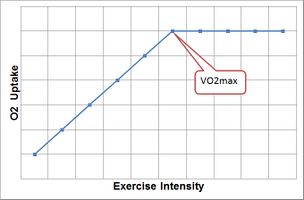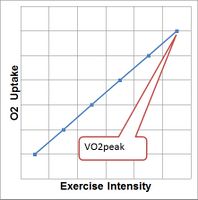VO2max
V̇O2max is the maximum (max) volume (V) of oxygen (O2) you can use during exercise. Measuring V̇O2max requires specialist equipment, but there are many locations with the facilities and the cost is usually under $100. The procedure involves running on a treadmill while wearing a mask to capture your breath. There is a warm up period, and then you run at a reasonably stressful pace while the treadmill gradient is steadily increased until you can't keep going. For most of the test, as the workload increases so does the O2 you use. However, there will come a point where the increased workload does not have a corresponding increase in O2 usage. This is the point where you are using as much O2 as you are capable of and you the increased workload is coming from anaerobic systems. While V̇O2max is interesting, it does not include details of Running Economy, so it does not give a complete picture of a runner's capabilities. Arguably, VDOT is a more useful measure of fitness.
1 V̇O2max and vV̇O2max
The velocity that is reached at V̇O2max is called vV̇O2max. An approximation of vV̇O2max is the mile race pace, but a more accurate formula is shown below[1].
vV̇O2max = V̇O2max /3.5
Where V̇O2max is in ml/Kg/min and vV̇O2max is in km/hr.
2 V̇O2max and V̇O2peak
Some research uses the term V̇O2peak rather than V̇O2max, and while the two are similar, there is an important difference. Where V̇O2max is the highest O2 uptake seen, even though exercise intensity has continued to increase, V̇O2peak is simply the highest O2 seen[2]. While V̇O2peak can be the same as V̇O2max, there is a lower confidence in the V̇O2peak value.

